|
Absolutely
fundamental to diving in the sea is an understanding of tides
and currents.
This page explains the basics:-
 Introduction Introduction
Divers need to have an understanding of tides since tidal
movement will have a major influence on sea dives and the
launching of boats.
The maximum water level is called high tide; the minimum level
is low tide. The time between high tide and low tide is called
ebb or falling tide, the time between low tide and high tide
is called flow, flood, or rising tide. At any given point
on the ocean, there are normally two high tides and two low
tides each day.
On average, high tides occur 12 hours 24 minutes apart. The
12 hours is due to the Earth 's rotation and the 24 minutes
to the Moon's orbit. The 12 hours is half of a solar day and
the 24 minutes is half of a lunar extension, which is 1/(29-day
lunar cycle).
The tides at a given place in the Earth's oceans occur about
an hour later each day. Since the Moon passes overhead about
an hour later each day, it was long suspected that the Moon
was associated with tides. It is the combined gravitational
pull of sun and moon that cause tidal flows. The moon causes
about 66% of that effect and the sun 32%.
The earth rotates every 24 hours and during that time there
will be two high tides (flood) and 2 low tides (ebb). However
the moon is also rotating around the earth, taking about a
month to do so. The net effect of this is that tides patterns
change every 24 hours and 52 minutes.
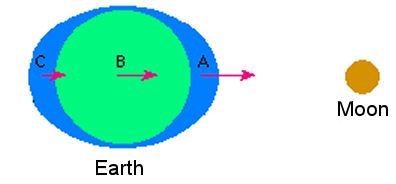 Consider
a water molecule in the ocean. whilst it is attracted gravitationally
by the earth, it also experiences a much smaller gravitational
attraction from the moon (much smaller because the Moon is
much further away and much less massive than the earth). Consider
a water molecule in the ocean. whilst it is attracted gravitationally
by the earth, it also experiences a much smaller gravitational
attraction from the moon (much smaller because the Moon is
much further away and much less massive than the earth).
The water nearest to the moon will have a stronger pull than
the water farther away. In this diagram there are two bulges
because of the differential gravitational forces.
The ocean at point A is closer to the Moon and experiences
a larger gravitational force than the Earth at point B or
the ocean at point C. Because it experiences a larger attraction,
it is pulled away from the Earth, toward the Moon, thus producing
the bulge on the right side. Loosely, we may think of the
bulge on the left side as arising because the Earth is pulled
away from the water on that side because the gravitational
force exerted by the Moon at point B is larger than that exerted
at point C. Additionally the earth is rotating under these
bulges. A given point on the surface will experience two high
and two low tides for each rotation of the planet.
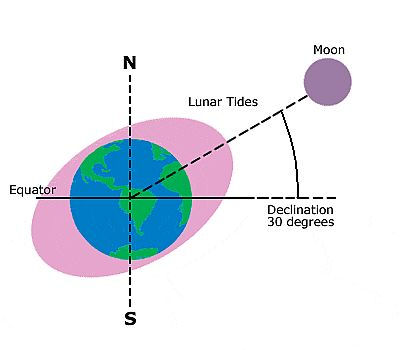 Every
27.3 days, the earth and the moon revolve around a shared
point, so the tidal pattern repeats the cycle in that time
frame. Every
27.3 days, the earth and the moon revolve around a shared
point, so the tidal pattern repeats the cycle in that time
frame.
Tidal times vary due to local geography. In extreme cases
there is only a single low tide and high tide each day.
In most of the world, the time between high and low tide is
consistent, approximately 12 hours and 25 minutes, which is
why the high and low tides seem to advance by an hour each
morning and evening, but low tide is not always half way between
them. In some places the flood tide rises quickly after a
long period of several hours of low water.
One of the most dramatic places in the world to watch a high
tide is in the upper reaches of the Severn Estuary. There
the high tide rolls in on a tidal bore, a wave that quickly
travels up river against the prevailing current. The phenomenon
is caused by the fact that the tide is funneled into a shallow
narrow river from a broad bay. This area has some of the most
dramatic differences in tidal height in the world.
Tides
are classified into two types; Neaps and Springs.
Neap Tides
When the moon and the sun are perpendicular to each other
their respective gravitational pulls (to a degree) counteract
each other. This results in weaker tides called neap tides.
To the diver this indicates slower currents. In this diagram
the moon is pulling the water one way and the sun another.
In the UK neap tides occur about 2 days after the first and
last quarter moons.

Spring
Tides
When the sun and the moon are lined up with the Earth as in
the examples below, large tides are experienced. These are
called spring tides. The effect on tides is about the same
whether the sun and moon are lined up or, on opposite sides
of the Earth. In the UK spring tides occur about two days
after new and full moons.
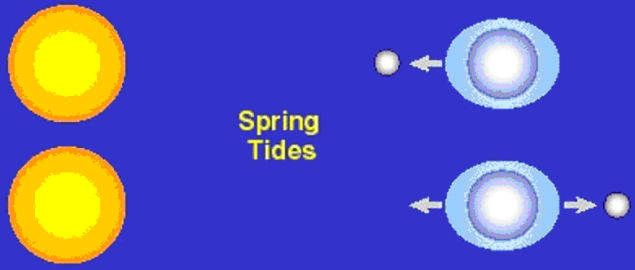
Phases
of the Moon
The phases that the Moon goes through are caused by two things:
1. The moon revolving around the earth,
2. The Moon reflecting sunlight towards the Earth.
Half of the Moon is always lit, not just the portion we see:
however, sometimes we only see a profile of the lit portion
of the Moon. Certain phases of the Moon result depending on
its orbit, and the Moon's orbit is responsible for the phase
changes we see.
Since we only see the lit portion of the moon that is facing
earth, we see a moon phase. There are eight phases that the
moon goes through and they always occur in the same order.
The Sun's light seems to move from right to left across the
surface of the Moon.
The phases of the Moon are:
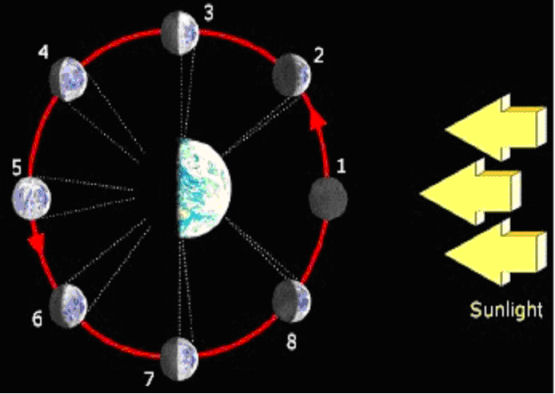
| 1.
New Moon |
(Day
0). Sun and moon are in Conjunction.Moon is not visible
because only the dark side is seen by the earth.This is
the biggest of the two spring tides. |
| 2.
Waxing Crescent |
(Day
3 to 4). Between new moon and first quarter, visible as
a crescent with the bow towards the West - waxing. |
| 3.
First Quarter |
(Day
7) Moon 90 degrees East of the sun, in East Quadrature,
it's bow to the West.
Waxing neap tide. |
| 4.
Waxing Gibbous |
(Day
11 to 12) Between first quarter and full moon, three quarters
of the disc visible, called a Gibbous Moon, rounded side
to the West, Waxing. |
| 5.
Full Moon |
(Day
15) Moon to the Sun's antimeridian, i.e. in Opposition.The
whole disk is illuminated, Spring tide. |
| 6.
Waning Gibbous |
(Day
18 to 19) Between full moon and last quarter,Three quarters
of the disc is visible, called a Gibbous moon, the more
rounded side towards the West, waning. |
| 7.
Last Quarter |
(Day
22), moon 90 degrees West of the sun, in West Quadrature,
visible as a half disc with it's bow towards the East
- waning Neaps. |
| 8.
Waning Crescent |
(Day
25 to 26). Between last quarter and new moon visible as
a crescent with its bow towards the East, waning. |
Spring
tides do not occur in UK waters until about 2 days after the
new and full moon. Similarly Neaps occur about 2 days after
the moon's quarters.The phases as shown above are explained
below:
A
Full moon will rise in the East. A New moon will rise in the
West.
Tidal
Stream Chart
This is shown on an Admiralty chart and used in conjunction
with magenta tidal diamonds. Details include Location, Set
(direction) in degrees true, Rate (speed or drift), and time.
'Sp'. and 'Np' refer to speed and not tidal height. Also shown
is the latitude and longitude of the diamond and the local
port to which the tidal differences are related to.
A Tidal Stream Atlas does the same as above and gives a quick
pictorial view of "Standard Ports".There is one
hour printed per page and one page covers only one area.To
find the set of the tide you must use either parallel rules
or a protractor.
Tides Make until they reach springs and Take Off until they
are neaps.When yachting you can either Stem which is to go
against a tide or Run which is to go with the tide. Also if
the wind is on the starboard side, the vessel is said to be
on the starboard tack, if the wind is on the port side, the
vessel is on the port tack.
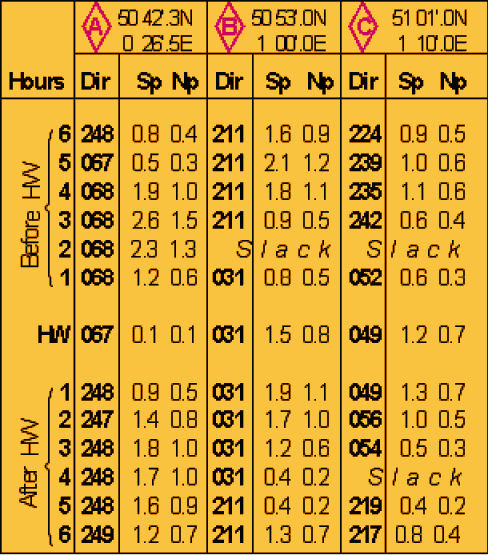
Tide
Tables
UK tide tables are usually given in Greenwich Mean Time (GMT),
not British Summer Time (BST). Therefore add one hour between
March 27th and October 23rd for BST.
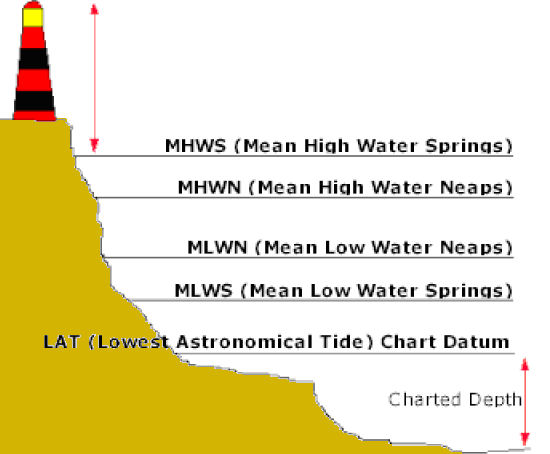
Rule of Twelfths
There are two methods of calculating tidal height and water
depth, one makes use of a 'tidal curve' and is preferred where
you need to be as accurate as possible. The second method
is known as the 'Rule of Twelfths' and can be easily calculated.
The level of water does not rise or fall at a constant rate
throughout the 6 hour duration of a rising or falling tide,
but the amount by which it will do so can be estimated mentally
by means of the following rough guide:
- 1st
hours rise or fall = 1/12 of Range
- 2nd
hours rise or fall = 2/12 of Range
- 3rd
hours rise or fall = 3/12 of Range
- 4th
hours rise or fall = 3/12 of Range
- 5th
hours rise or fall = 2/12 of Range
- 6th
hours rise or fall = 1/12 of Range
Assume that after looking at the relevant tide tables, a party
plan to dive a wreck at 4pm. The tidal range is 6 meters and
the depth at low water (1 pm) is 10m.
Each twelfth would = 0.5m ( tidal range / 12 = 0.5m)
|
Time
|
Twelfths
|
Additional
Depth
|
Depth
at
Wreck
|
|
1.00
pm
|
|
|
10.0
m
|
|
2.00
pm
|
1/12
|
0.5
m
|
10.5
m
|
|
3.00
pm
|
2/12
|
1.0
m
|
11.5
m
|
|
4.00
pm
|
3/12
|
1.5
m
|
13.0
m
|
|
5.00
pm
|
4/12
|
1.5
m
|
14.5
m
|
|
6.00
pm
|
5/12
|
1.0
m
|
15.5
m
|
|
7.00
pm
|
6/12
|
0.5
m
|
16.0
m
|
|